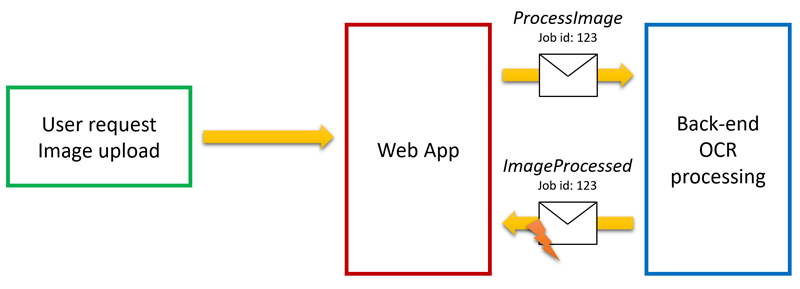
The case of NServiceBus long running jobs: OCR Processing.
Designing systems using a message based architecture is awesome. Messages are a nice way to design human interactions and to model how different components in a domain interact with each other. Unfortunately, technology sometimes causes more headaches than needed. And when it comes to messaging, long running jobs are a interesting headache to deal with.
OCR Processing
Let’s say that our users need to process images and extract text using an optical character recognition system (OCR). This is done via a web interface that allows users to upload images for processing.
Images processing takes time and is done in background, when processing is completed users are notified that the results of their background jobs are ready to be consumed.
This process can be outlined as follows:

OCR processing can take a long time and we don’t want to hold the incoming user request until the work is completed. An interesting option is to offload the OCR work to a back-end system:
- User request is received by the web application
- Web application sends a message on a queue to a back-end processing system
- Back-end processing system processes the image
- When processing is done an event (again a message) is sent through the queuing system
- Web app reacts and notifies the user, e.g. via SignalR
Have we solved the issue?
Not really. Back-end processing cannot happen in the context of the incoming message, queuing systems have the concept of transactional processing that affects the time we have to process the incoming message.
There are transactional queuing systems that have to respect transaction timeouts and non-transactional queuing systems based on peek and lock (or similar) concepts meaning that a message, once picked by a processor, is locked for a certain amount of time and then released to the queue if processing doesn’t happen in that timeframe.
In such a scenario increasing the transaction, or lock, timeout is not a solution. It’s just a way to postpone the problem at a later time.
The state machine and the processor
A closer look at the business problem shows that there are two different business concerns being mixed together:
- the need of keeping track of the state of processing jobs using a state machine:
- Job started
- Job in progress
- Job failed for a known reason
- Job failed for an unknown reason
- Job completed successfully
- the OCR processing work
NServiceBus Sagas are a perfect fit for the state machine. As mentioned before, due to the transactional behavior of queuing systems, messages are not a good solution when it comes to long processing time.

The backend is now split to handle the two concerns. It’s obvious that the communication technology across the OCR state machine and the OCR worker process cannot be queue based.
Conclusions
Using the above scenario I put together a proof of concept that shows how it can be implemented. It’s available on my GitHub account in the NServiceBus.POCs.OCRProcessing repository. This sample uses WCF to allow the OCR state machine and the OCR worker process talk to each other.
There is also an official sample showing how to design the same processing logic using Azure ServiceBus in the NServiceBus documentation.